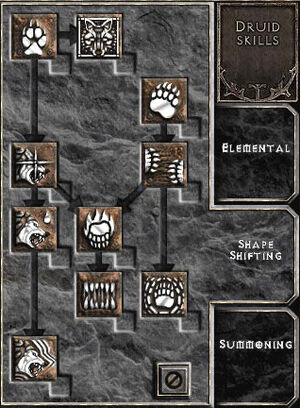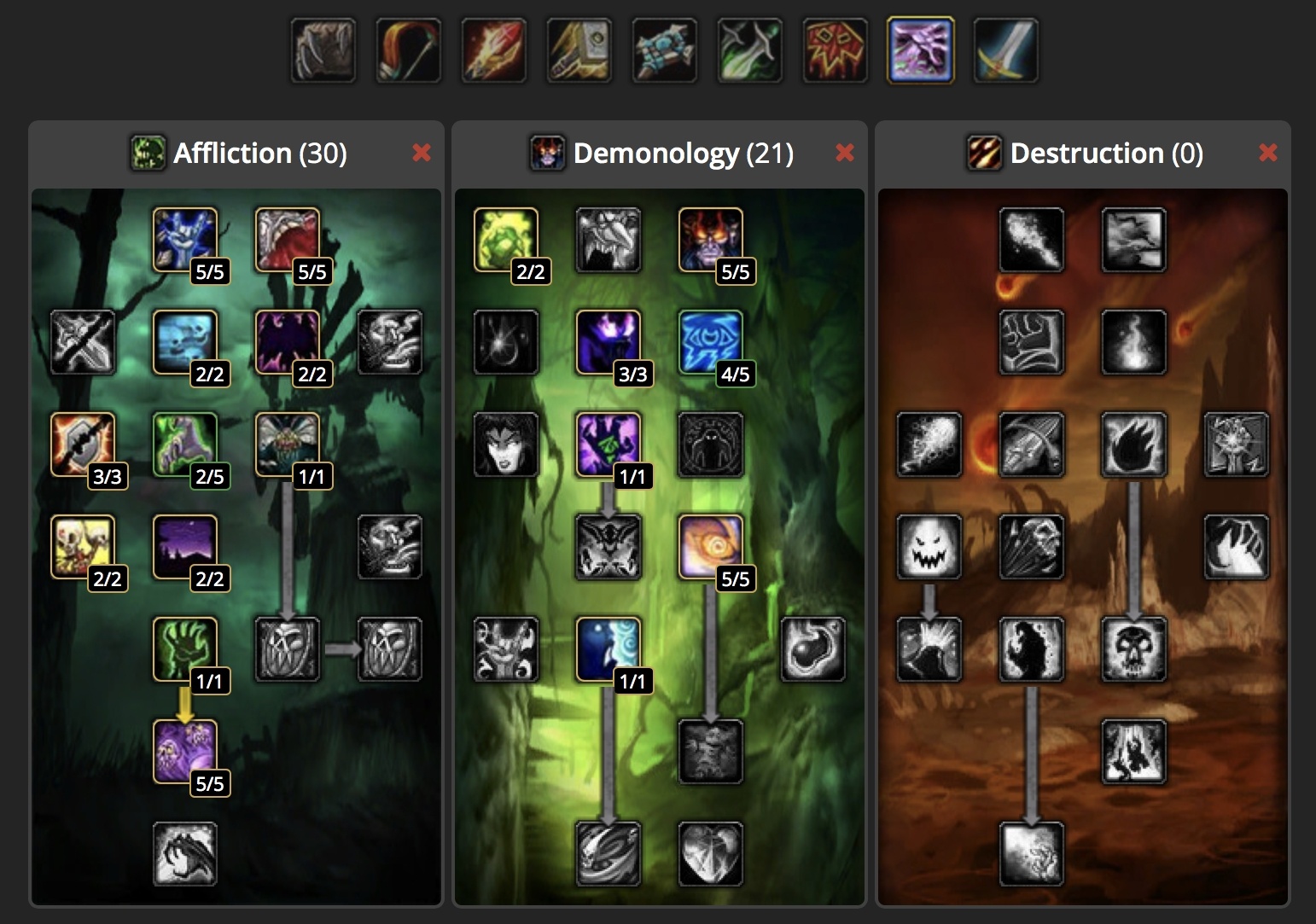-
Notifications
You must be signed in to change notification settings - Fork 13
Skill Trees ~ Components of Exemplary Skill Trees
Skill trees complement RPG narratives, empowering the game player to upgrade their avatar. One of the most important factors when considering skill tree design is the degree of player agency within the game. For example, Spider-Man (2018) implements a limited skill tree, allowing the player to develop a specific fighting style, while World of Warcraft implements a more flexible skill tree, because players are not confined to a single titular archetype (i.e. Spider-Man); rather, they can elect from a variety of player races/factions.
| Contents |
|---|
| 1. General Skill Tree Anatomy |
| 2. Diablo Skill Tree |
| 2.1 Skill Types |
| 2.2 Skill Organization |
| 3. World of Warcraft Skill Tree |
| 4. Path of Exile Skill Tree |
| 5. Takeaways |
| 6. Sources |
- Top tree nodes are the easy-to-acquire skills from which a player develops more advanced skills
- Each of these nodes defines a skill category, such as player health, magic spells, combat moves, etc.
- Gating mechanisms define when a player can acquire a skill; good game design ensures skill acquisition progresses in a balanced way (@VannStrasen is researching how to balance skill trees in Sprint 1)
- Skill tree nodes should communicate the effect of the specific skill, so that the player knows how to use it; some skill tree designs even contain previews of skills to follow in each existing node, so that the player knows what to expect/look for
- It is best if the skills acquired do more than give power to the player, by actually changing the way the game is played (e.g. acquisition of combat skills renders the game more dangerous by also introducing more enemy characters?)
- Consider the extent to which skill trees should be allowed to be reset (fewer resets means more re-playability, as the gameplay will vary more, but can frustrate a game player if they make the wrong choices for their desired skill tree development)
- Total number of skills a player can possess at any point in time is limited (a design choice that enhances/complicates gameplay)
- Skills are categorized into Active, Passive, and Active/Passive
- Active skills must be manually activated and can either be Channeled (after activation, the player must maintain the effect of the skill, a spell cast, with a repeated action) or a Summon (a minion character will materialize to help the game player in their battles/endeavors)
- Passive skills do not need to be activated; once acquired, their effect is lasting or triggered by other events in the game
- Active/Passive skills exhibit a blend of active and passive skill behavior (e.g. "auras" have a passive effect but can occasionally be activated for player bonuses)
- Diablo skill trees are navigated with tabs that categorize the trees into "Druid Skills," "Elemental," "Shape Shifting," and "Summoning"
- Each tree displays the skills in rows, with each row signifying the level at which they become available for acquisition (the top row of skills is available at the game avatar's inception)
- Arrows between skills indicate which skills are prerequisites for others
- Possessing certain combinations of skills can passively enhance the effect of those skills
- Skills for professions can be "created" or "harvested," while riding skills must be purchased from riding trainers (i.e. active skill acquisition mechanisms, via construction, training, quest completion, or purchase, as well as chance skill acquisition mechanisms)
- The ability to use specific tools (e.g. weapons, armor) depend on the skills acquired by the player; skills indirectly empower the player by providing access to advanced technology
- Player races determine the starting skillset and the class of skills the player should strive to acquire (e.g. as a death knight, rune-forging skills are a prerequisite for engraving runes on weapons)
- Earned through a quest reward
- Purchased from town vendors once a certain quest is complete
- Vendor recipes
- Random drop from monsters, chests and strongboxes
- Vaal skill gems are obtained from Vaal Vessels in corrupted areas or by corrupting a regular skill gem
- As a reward for turning certain sets of divination cards
- Skill gems also have associated levels, so even after a skill is acquired, the skill can be upgraded to higher levels to result in better performance (usually by collecting experience points associated with using the skill)
- A unique skill tree for each distinct category of skills, unless the game supports only one category of skills (e.g. only magic spells)
- Gating mechanisms that determine how/when a skill can be acquired
- Short comments on each skill node with a description of the skill (what the player can use it for) and perhaps a hint at what the player can do to acquire the next skill after it
- Limited skill tree resetting abilities: a Chiventure game developer should be able to determine whether a player of their game can hold unlimited skills or only a limited number of skills at a time. If only a limited number at a time, the option to possibly remove skills to make room for other ones should be available. Otherwise, the game player will always have to face the consequences of electing certain skills over others, with no room for skill-selection error.
- We should have templates for how Chiventure game developers can organize their skill trees, whether with only one category of skills or several, as well as templates for how skill trees should be displayed on the command line
- Chiventure game developers should be able to specify the foundational skills a player of their game begins with, and, depending on the progress of
x/rpg-playerclass, we could also support defining different starting skills for each player class. - We should have gating mechanism events. The analogy here is to JavaScript events like
onClickoronLoad, etc. So, in Chiventure, we could haveonPurchaseoronQuestCompletionas events that trigger skill acquisition. We would have to work withx/action-management,x/custom-scripts, and/orx/wdlto decide on how these events would be specified. Also, currently, there is nox/rpg-questteam, soonQuestCompletionis just an example; its implementation will have to be considered by future generations of Chiventure developers. - The skill trees library of functions should be focused on triggering skill acquisition (see above point) and supporting skill usage by game players.
- Down the line in Chiventure development, with multiplayer support, we should also be able to support the ability of players to trade skills.
A good summary of skill trees in well-known RPGs
-
Action Management
-
Battles
- Design Document
- Text Based Combat in Other Games
- User Stories
- Wishlist
- Battle Planning 2022
- Battle User Stories Review 2022
- Structs in Other Modules Related to Battles 2022
- Stat Changes Design Document
- Run Function Design Document
- CLI Integration Design Document
- Move Changes Design Document
- Unstubbing Stubs Design Document
- Battle Items and Equipment Design Document
- Battle Item Stats
- Battles Demo Design Document
- Battles Testing Moves, Items, and Equipment Design Document
- Sound integration with battle (design document)
-
Custom Actions
-
Custom Scripts
-
DSL
-
CLI
-
Enhanced CLI
-
Game-State
-
Graphics
- Design Plan
- Design document for integrating split screen graphics with chiventure
- GDL (Graphical Description Language)
- Graphics Sandbox
- Design Document for NPC Graphics and Dialogue
- Feature Wishlist (Spring 2021)
- Installing and Building raylib on a VM
- LibSDL Research
- Module Interactions
- Working with Raylib and SSH
- raylib
- GDL
-
Linking the Libzip and Json C to chiventure on CSIL machines
-
Lua
-
NPC
- Dependencies: Player class, Open world, Battle
- Action Documentation
- Design Document for NPC Generation in Openworld
- Design and Planning
- Establishing Dependencies
- Implementation of Custom Scripts
- Independent Feature: NPC Movement Design Document
- Player Interaction Design and Planning
- Dialogue
- Design Document for NPC Dialogue and Action Implementation
- Loading NPCs from WDL Files
- NPC Battle Integration Design Document
- NPC Battle Integration Changes Design Document
-
Open World
- Autogeneration and Game State
- Deciding an integration approach
- Designing approach for static integration into chiventure
- Feature Wishlist
- Generation Module Design layout
- Potential connections to the rest of chiventure
- Single Room Generation Module Design
- Source Document
- User Stories
- World Generation Algorithm Plan
- Loading OpenWorld Attribute from WDL
-
Player Class
-
Player
-
Quests
-
Rooms
-
Skill Trees
- Avoiding soft locks in skill tree integration
- Components of Exemplary Skill Trees
- Design Document and Interface Guide
- Environment interactions based on skill characteristics
- Integrating complex skill (combined, random, sequential, etc.) implementation
- Integration of a Leveling System
- Potential Integration with existing WDL
- Research on game balancing in regards to skill trees
- Research on skill tree support in modern day game engines
- SkillTree Wiki Summary
- Skilltree "effect" implementation and roadmap
- Summary of md doc file for skilltrees
- Design ideas in connection to other features
- Summary of Skill Tree Integration 2022
- The Difficulty of the Reading the World
- Complex Skills Summary
-
Sound
-
Stats
-
WDL


